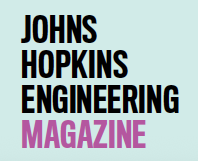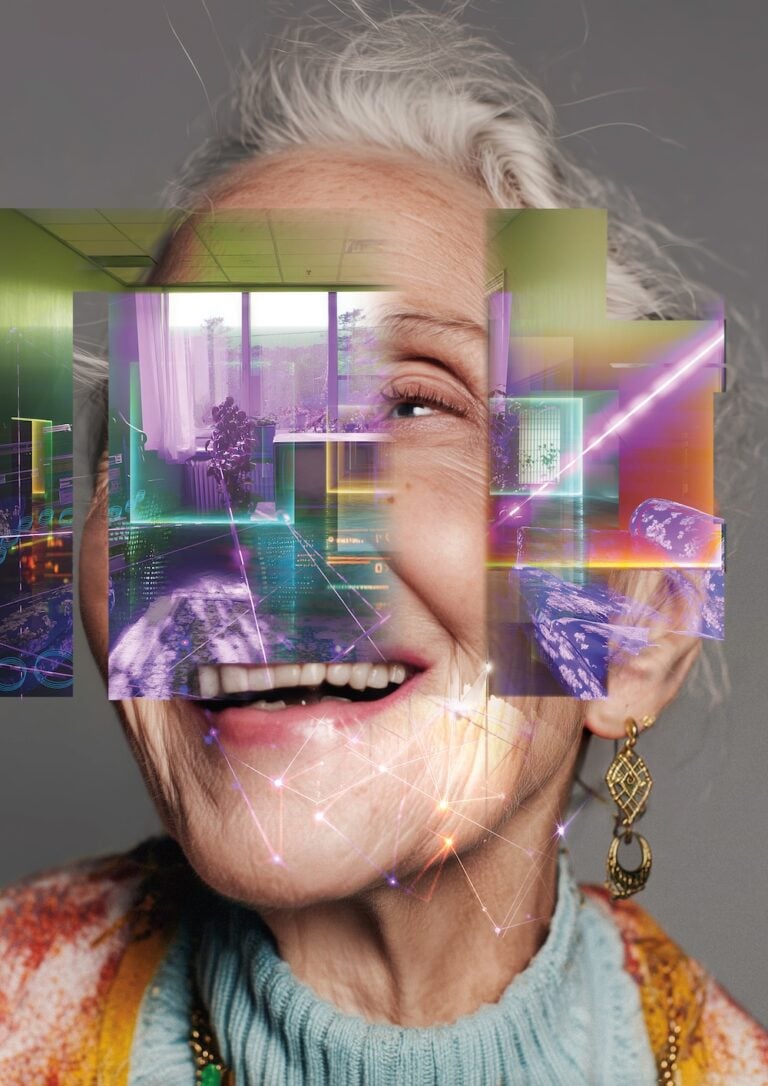In a cozy apartment, an older woman sits in an armchair, raptly attuned to a scene unfolding on her virtual reality glasses. She chats amiably with a virtual tour guide, who is leading her through the Baltimore Museum of Art. Two Johns Hopkins graduate students— one in engineering, the other in nursing—sit nearby, taking notes to fine-tune this personalized, AI-generated tool. It is aimed at providing social interaction to stave off loneliness, a significant risk factor for cognitive decline in older adults.
Down the hallway, Laureano Moro-Velazquez, an assistant research professor of electrical and computer engineering at the Whiting School, and neurologist Ankur Butala lead a man in his 70s through a series of reading and writing exercises on a digitized notepad. An array of sensors tracks the movement of the man’s eyes, the cadence of his voice, and the movement of his hand. The researchers will continue to assess the man’s reading and handwriting every few months. Their overarching goal: to detect neurodegenerative diseases like Parkinson’s or Alzheimer’s in their earliest—and most treatable—stages.
Meanwhile, in a large lab space nearby known as the “motion capture room,” Laura McDaniel, a second-year PhD student in electrical engineering, is quite literally putting an older woman through her paces. Sixteen cameras are set up in pairs throughout the room, tracking the woman’s gait in real time as she walks across the room, and then moves through a series of exercises on a treadmill. The data McDaniel collects, part of a study led by Rama Chellappa, Bloomberg Distinguished Professor in electrical and computer engineering and former interim director of the Data Science and AI Institute, is aimed at detecting factors—such as misaligned hips or hunched shoulders—that could impair the woman’s balance and put her at risk for a fall.
3.1%
In 2024, the U.S. population age 65 and older rose by 3.1%, to 61.2 million people, according to the U.S. Census Bureau.
These three projects are just a few of many efforts that are unfolding—some now, others in the months and years to come—in a new hub for healthy aging research, which opened in July at the Johns Hopkins Bayview Medical Campus in East Baltimore under the umbrella of the Johns Hopkins Human Aging Project (HAP). The 10,000-square-foot center gives the engineering school a prominent presence on the medical campus and is bringing together faculty and students from engineering and medicine—as well as nursing, public health, and business—with older adults and their caregivers to test technology-driven solutions to some of the biggest challenges older adults face.
These include social isolation, mobility issues, and neurodegenerative decline, notes Najim Dehak, associate professor of electrical and computer engineering at the Whiting School and co-director of the new hub. “Our aim,” he says, “is to leverage technology to extend the time that older adults can remain living safely and independently at home.” Dehak has even coined a term for this new area of translational research, which is reflected in the hub’s name: Geriatrics Engineering at Johns Hopkins.
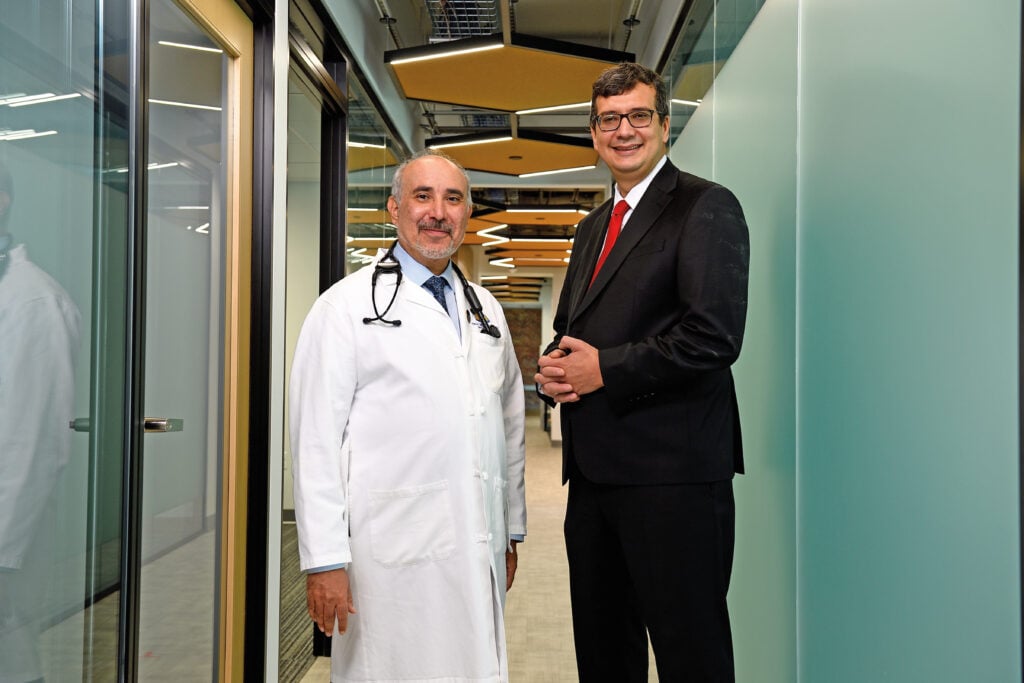
Peter Abadir (left) and Najim Dehak
“We aren’t just building gadgets. We’re creating scalable solutions to meet older adults where they are—in their homes, or senior centers, or their doctor’s office.” — Peter Abadir
With its plentiful conference rooms, labs, and offices, as well as a model apartment that simulates a realistic living space of an older adult, the hub notably provides a new home for the Johns Hopkins Artificial Intelligence & Technology Collaboratory for Aging Research. Established in 2021 with $20 million in funding from the National Institute on Aging, the AITC currently has 129 pilot projects—like the loneliness-combating VR glasses—up and running. Developed by research teams at Johns Hopkins and universities and tech incubators around the country, some AITC projects have spawned prototypes that are already in market testing.
The goal with AITC projects and other research efforts unfolding in the new facility is to move innovations as quickly as possible into affordable solutions that seniors of all income levels can easily use, says geriatrician Peter Abadir, who co-directs the new facility. He notes that faculty and graduate students from Johns Hopkins’ Carey Business School are actively engaged on many projects (see sidebar) to ensure that products can be marketed successfully and made widely available and affordable.
“We aren’t just building gadgets. We’re creating scalable solutions to meet older adults where they are—in their homes, or senior centers, or their doctor’s office,” Abadir says. “We’re bringing engineers from the Homewood campus together with clinicians in East Baltimore to work shoulder by shoulder, quite literally, to design and validate technology that will help older adults live independently for longer, and with dignity.”
“It’s so important for older adults to be included in the design of any new ‘smart home.’ They need to be a part of the conversation.” — Najim Dehak
Leaders of Geriatrics Engineering at Johns Hopkins, believed to be the first of its kind in the country, point to the nation’s rapidly graying population and note that the timing for such work is critical: In 2024, the U.S. population aged 65 and older rose by 3.1%, to 61.2 million people, according to the U.S. Census Bureau. By 2030, an estimated one in five Americans will be retirement age. Meeting the functional, cognitive, and psychosocial needs of this burgeoning wave of older adults with accessible, technology-driven solutions will be crucial—and a complex challenge, says Ed Schlesinger, Benjamin T. Rome Dean of the Whiting School of Engineering, and an early and ongoing champion of the collaborative space.
“There is really no university today that is better equipped to lead in this area than Johns Hopkins. If anyone can do this, we can,” he says, noting that Johns Hopkins is home to the nation’s top-ranked biomedical engineering program, which unites the Whiting School and the School of Medicine. Moreover, the Bayview campus is already the site of many well-established, geriatrics-focused clinical programs and research centers, which will afford easy access to, and collaboration with, clinicians and their older patients and caregivers, Schlesinger says. By bringing together a diverse array of experts from many disciplines at Johns Hopkins, he notes, “We aim to ensure solutions that are equitable, inclusive, and ethically sound.”
‘Smart Home’ of the Future
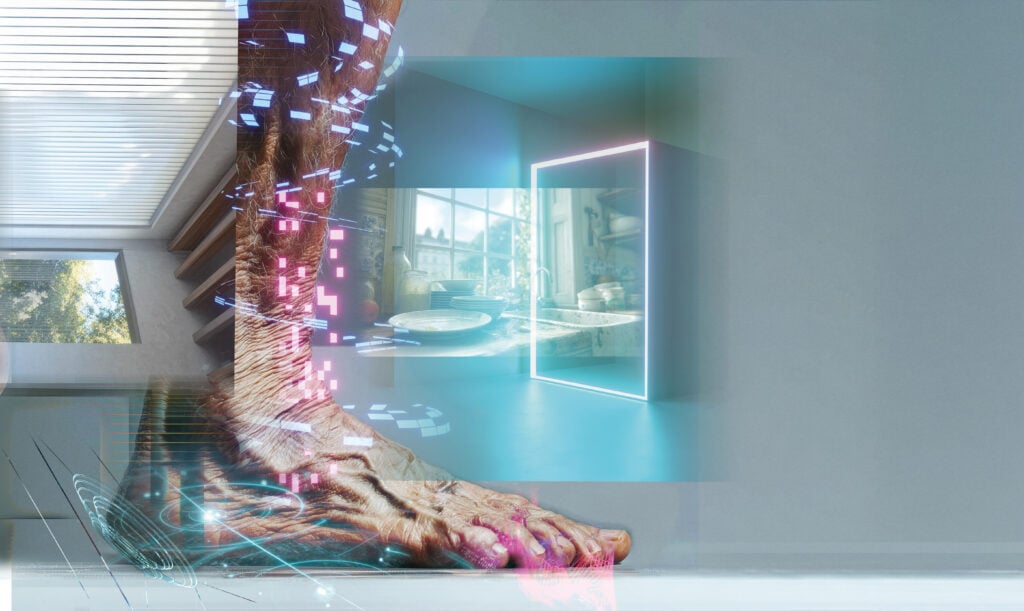
A focal point of Geriatrics Engineering at Johns Hopkins is the model apartment, which includes a living room, kitchen, bedroom, and bathroom. While planners were still in the process of furnishing the living space in early fall, they are intent on creating a look and feel that is both comfortable and familiar for older adults and their caregivers—clutter and all.
“So much technology currently on the market is developed by testing it on young people, then reverse-engineered for older adults, and it’s developed in a sterile, studio-like setting,” says Abadir. “Here, we are starting with older adults and determining their needs to make sure the technology we develop is relevant to them, in the places where they live.”
Dehak concurs. “It’s so important for older adults to be included in the design of any new ‘smart home.’ They need to be a part of the conversation.” Toward that end, in the months ahead, both older adults and their caregivers will visit the model apartment to try out and provide feedback on the wearable trackers, robotic assistants, and voice-activated systems that will be tested there.
Driving the new technology are rapid advances in AI and sensor technology, which offer the promise of truly personalized interventions that planners aim to make widely accessible.
One AITC project capitalizing on those advances, Sovrinti: Data for Daily Living, leverages real-time location and device utilization data to identify rising health risks so that family members can intervene before a problem becomes acute. Some sensors measure and track the water temperature of an older adult’s kitchen faucet, for example, as well as the oven and dishwasher.
Light sensors track how often—and when—the user opens cabinets, drawers, and the refrigerator. A Wi-Fi-equipped router detects and measures the resident’s movements throughout the apartment.
By automatically quantifying change in an older person’s movement and behavioral patterns, Sovrinti—led by a research team at Baylor University—can flag worrisome changes early on. “A caregiver could feel secure in leaving their loved one living on their own if their parent’s apartment is equipped with AI-driven tools like that,” says Abadir.
While Sovrinti has already moved through early trials, Abadir and Dehak envision similar sensor-and data-driven AITC solutions undergoing testing in the model apartment in the months ahead. They point to an Alexa-type device that uses voice cloning to personalize reminders—“Mom, did you take your morning medication?”—for those in the early stages of cognitive decline, as well as a robot that can help an older adult with teeth brushing.
1 million
The number of older adults in the United States with Parkinson’s disease, a progressive neurological movement disorder
The long-term goal, says Dehak, who is a leading expert in human language technologies, is to create a model for the personalized senior apartment of the future, where sensors detect infirmities of aging at their earliest stages and voice activation devices can keep older adults safe and feeling socially connected.
“We’ve already reached a stage with automatic speech systems where we can provide adaptive dialogue,” says Dehak. “While in the past, we were limited to scripted dialogue, now it’s possible to adjust the response and ask different questions.” A voice-activated digital assistant might start with, “How are you feeling today?” If the senior responds that they are feeling down, the system could respond with, “You often feel sad when it’s raining outside. Perhaps you could phone your friends, Mary and Doug, to check in on them?”
Even if an older adult isn’t aware they are feeling low, speech technology advances that Dehak has led can now detect the early signs of depression through the intonation and cadence of the person’s speech. In the not too distant future, he says, a daily recording device could be used to track an older person’s speech and alert their doctor to an early change in their mental health status.
“Most older people only see their doctor every few months. This would allow a much quicker intervention,” says Dehak, citing a crucial benefit driving much of the AI-fueled work underway at the center: the ability to provide daily (even minute by minute) monitoring that can detect physical and behavioral changes before they turn into problems.
Getting Granular
As Butala gestures to the high-tech setup in the new space that he and Moro-Velazquez are using to track the eye movement, voice, and handwriting of older adults, the neurologist foresees a future where doctors can both detect and measure neurological decline in its earliest phases.
“Right now, our evaluations are so subjective,” he says. “When I assess an older patient, I might note that his stroll is a little slower than his last visit, or if I ask him to follow the movement of my finger with his eyes, it’s a relatively crude measure. What neurologists are lacking is a consistent method of granular, cognitive behavioral characterization.”
“The bulk of medical care today is delivered at the primary care level. There are huge swathes of older people who don’t have access to neurologists, much less subspecialists.” — Laureano Moro-Velazquez
That’s particularly important when it comes to assessing how well a particular drug might be working in treating a patient’s Parkinson’s disease, a progressive neurological movement disorder impacting about 1 million older adults in the United States, he notes. Levodopa (L-DOPA) is commonly prescribed to help regulate movement in PD, but getting the dosing right is a trial-and-error affair that depends on self-reporting from the patient and can stretch over months or years.
Key to the AI-driven system the two researchers have developed, under the leadership of Dehak, is its “multimodal” aspect. By measuring eye movement, speech, and handwriting simultaneously, the researchers can gather that granular data (known as “deep phenotyping”) that can capture minute changes in a patient’s condition over time that might otherwise go missed if only one area is examined.
In eye tracking of hundreds of older adults to date, for example, they have found that while healthy people often skip over words as their eyes scan a reading passage, people with early Alzheimer’s disease tend to look at every word and spend more time on complicated words. “This in turn influences their speaking pattern,” says Moro-Velazquez.
He and Butala are also using a pad and sensors in the shoes of older people with Parkinson’s and Alzheimer’s to characterize changes in their gait over time.
Ultimately, the two researchers hope the data they are gathering will move out of the lab in Johns Hopkins’ hub for aging research and into the offices of primary care doctors across the country, in the form of easy-to-use, affordable diagnostic tools.
“The bulk of medical care today is delivered at the primary care level. There are huge swathes of older people who don’t have access to neurologists, much less subspecialists,” notes Moro-Velazquez
Both researchers are adamant that the progress they’ve already made, and the promising applications on the horizon, would not be possible if they were not working alongside one another and countless other engineers, data scientists, students, and geriatrics specialists on a daily basis. “Sometimes as engineers, we come up with solutions and then look for a problem—creating solutions nobody needs. We need to better communicate with doctors and understand the problems they need us to solve,” says Moro-Velazquez.
Abadir concurs. “This new space offers an opportunity to iterate in real time. Clinicians talk with engineers, bring in older adults for their testing and feedback, and then make adjustments. When you bring everyone together, then the magic happens.”
Abadir and Schlesinger believe so strongly in this “magic” that they are taking it to a national stage. In an editorial they co-published in July in the Journal of the American Geriatrics Society (JAGS), the duo announced the launch of a new section in the journal: JAGS-AI & Tech, which they described as “a multidisciplinary platform for research, innovation, and dialogue at the intersection of geriatrics, engineering, data science, business development, and ethics.”
It’s notable that the editorial marked the first time that an engineer has authored an article in the medical journal. While Schlesinger won’t have an editorial role moving forward, his support reflects a shared conviction, “that the next chapter in geriatric research and care, marked by the emergence of AI and associated technologies, must be co-written by clinician-scientists and engineers working together as peers.”
Up to the Test
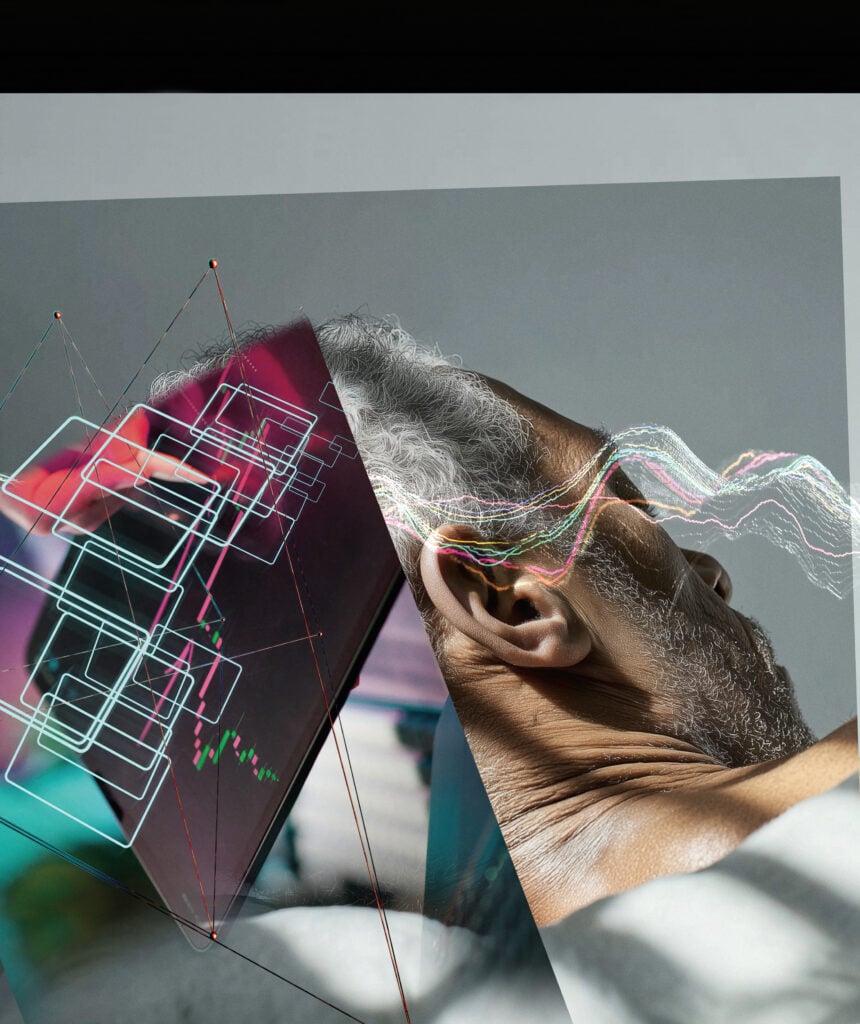
The hub for translational aging research at Johns Hopkins Bayview also offers meeting and research space for the Gerotech Incubator program, which launched in 2021 and is co-directed by Najim Dehak and Peter Abadir. The program brings together Johns Hopkins students and trainees in engineering, medicine, nursing, and business to work closely with interdisciplinary teams of Johns Hopkins faculty members. Their goal: to develop and bring to market affordable tools and therapeutics aimed at improving the quality of life for older adults.
One group, for example, has developed and piloted a headset that promotes deep sleep that may protect against Alzheimer’s and other physical and cognitive decline. Called inWave, it uses electroencephalography to monitor brain activity and an AI algorithm to time the delivery of specialized sounds that enhance the kind of brain activity needed for deep sleep.
